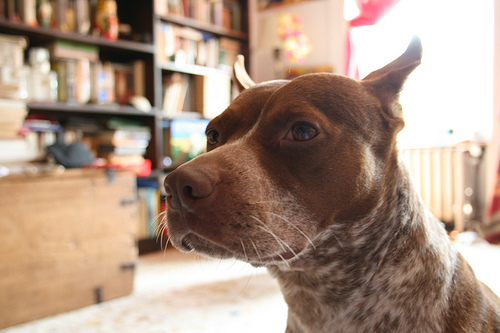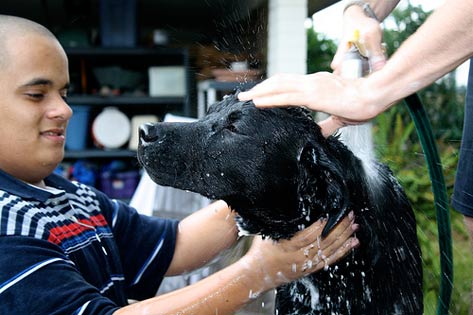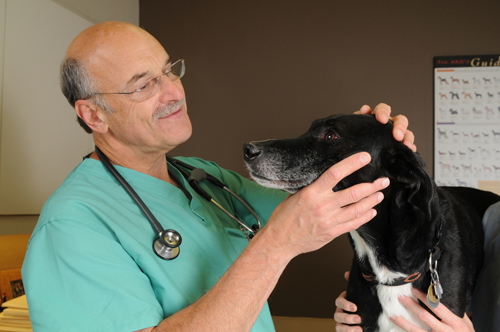

By T. J. Dunn, Jr., DVM
If you a proud owner of a purebred pup, there are many choices and decisions to be made. One of the most difficult decisions for you may relate to ear cropping.
Some breeds of dogs through the ages have traditionally been recognized partly by the distinctive look of their head; cropped ears have become their trademark. Doberman Pinschers and Great Danes come to mind right away. And even many of the smaller breeds such as the Miniature Schnauzer have traditionally had their ears surgically changed to give them a distinctive appearance.
In our modern times, many have come to question the need or advisability of cropping the ears of dogs. In fact, some countries have gone as far as to ban the practice.
The aspect of animal cruelty comes into play in that many people will argue that there is no medical, physical, environmental or cosmetic advantage for the dog to have the pinnas (the ear flaps) surgically altered. And to subject any dog to the "disfiguring" and unnecessary surgical procedure and subsequent taping and bandaging that sometimes needs to be done after the surgery amounts to animal cruelty and is indefensible.
There are others that will argue that for some dogs, the cropped ear will help prevent ear canal infections and make the opportunity for pinna trauma and infection much less likely. They will state that the ear cropping is no different philosophically or ethically than any elective surgery such as spaying and neutering or removing protruding dew claws.
The fact is that ear infections are common in all sorts of breeds, whether they have cropped ears or not. As a veterinarian with 32 years of experience treating hundreds of thousands of dogs during that time, I cannot find medical justification for cropping a dog's pinnas (outer ear). So the choice to crop a dog's ears is a personal decision that a purebred dog owner needs to weigh carefully -- partly because what you think you will get may not occur.
I refer to the disappointing cases where the pup's ears have been cropped and yet, no matter what everyone tries to do, the ears won't stand erect!
There are many reasons why this can occur, including:
The following is a discussion with a dog owner via e-mail:
QUESTION: My Great Dane's ears will not stand up, what can I do myself to get them to stand? He is 10 months old. S. P., Florida
ANSWER: This is a very frustrating situation, Sherry, because, in fact, there may be nothing you can do other than additional meticulous and difficult surgery to get the ears to stand. Especially by this age, if the ears won't stand they simply are not going to. No amount of "calcium supplementation, massage, acupuncture, protein supplementation, etc" will make the ears stand erect. You are not alone in this because many purebred dog owners have been disappointed that their dog's ears would not stand. The time to really get at this, too, has long passed. Generally, if the ears aren't standing at 4 to 5 months of age they aren't going to stand erect. I wish I had a better solution for you.
Best wishes, Dr. Dunn
If it wasn't made clear in my answer to Sherry, supplementing a pup's diet with extra calcium in the hope that it will "build up" the ear cartilage is not scientifically or biochemically valid. In fact, adding additional calcium above the usual balance of that mineral with phosphorus and vitamin D has actually been shown to cause growth problems in dogs.
Of course all pups should be fed an optimum diet, but supplementing an already high quality diet will have no additional benefits. The pup "loosing it's teeth" has no impact on the strength or rigidity of the pinnas, either.
In my first year of practice in a very busy, multi-doctor small animal hospital in an affluent Chicago suburb, we had a surgeon on the staff who was noted for his ability to crop ears. Every day we would admit purebred dogs from all over the area for the surgery and post surgical bandaging.
As a "new" veterinarian I watched with interest all aspects of the ear cropping protocol -- from the initial physical exam, interview with the owner regarding what they expected the ears to look like, the anesthetic administration, surgery, post operative bandaging and patient recovery.
I assisted with rebandaging those pups that came back in because one or both pinnas were not standing properly. I assisted in cleaning and treating the occasional case where the incisions became infected; I listened as a disappointed dog owner sternly questioned the surgeon about "what went wrong with the surgery" when one or both ears did not stand erect.
All the while these procedures were taking place, and while I observed the occasional dog owners who were angry, frustrated, and disappointed that their prized purebred dog would never "look right", I would concentrate on the patient. I always felt just a twinge of conscience about what the dog must be feeling as it sat patiently with an inquisitive eye on the humans attending to it.
I decided, after considering all the pros and cons surrounding the ear cropping procedure, that when I opened my animal hospital I would not perform the ear cropping procedure.
I have owned three animal hospitals since my first year out of veterinary school back in 1970. And though I still choose not to do ear cropping, I will take on bone fracture repair, gastric dilatation (bloat) correction, tumor removals and just about any surgery an experienced veterinarian will do.
The income lost was a non-factor in my decision not to do ear cropping. (Many veterinarians have to charge well over $150 per pup due to the anesthetic, surgery, bandages, hospital stay, and also will charge for rebandaging, suture removal, antibiotics, etc. So a litter of ten pups for ear cropping can generated sizeable income.) The revenue for a practice can be substantial for doing ear cropping. But my decision not to do this surgery was a simple personal choice on my part.
As your pup's caretaker, you have a choice, too. Weigh all the pros and cons, and then make your decision. Expect to be criticized by those who disagree with your choice.
I was criticized by a number of breeders for NOT doing the surgery -- they seemed put-out by the fact that they had to find another veterinarian to do it.
But just as the decision not to do the surgery in my practices was my personal decision to make, so it is your choice whether or not it will be done on your dog.
Image: Sugar Pond / via Flickr
 6 Signs it’s Time to Change Your Dog’s Food
Choosing a dog food can be a painstaking process —
6 Signs it’s Time to Change Your Dog’s Food
Choosing a dog food can be a painstaking process —
 Caring for Your Pet’s Skin During the Winter Season
By the time we reach adulthood, most of us have d
Caring for Your Pet’s Skin During the Winter Season
By the time we reach adulthood, most of us have d
 10 Ways to Stop Fleas from Biting Your Dog
Ah, the joys of Spring and Summer. The re
10 Ways to Stop Fleas from Biting Your Dog
Ah, the joys of Spring and Summer. The re
 Top Ten Fourth of July Pet Safety Tips
By Yahaira Cespedes
Like many Ameri
Top Ten Fourth of July Pet Safety Tips
By Yahaira Cespedes
Like many Ameri
 The Physical Exam: What to Expect at the Veterinarian's Office
By T. J. Dunn, Jr., DVM
It is alway
The Physical Exam: What to Expect at the Veterinarian's Office
By T. J. Dunn, Jr., DVM
It is alway
Copyright © 2005-2016 Pet Information All Rights Reserved
Contact us: www162date@outlook.com